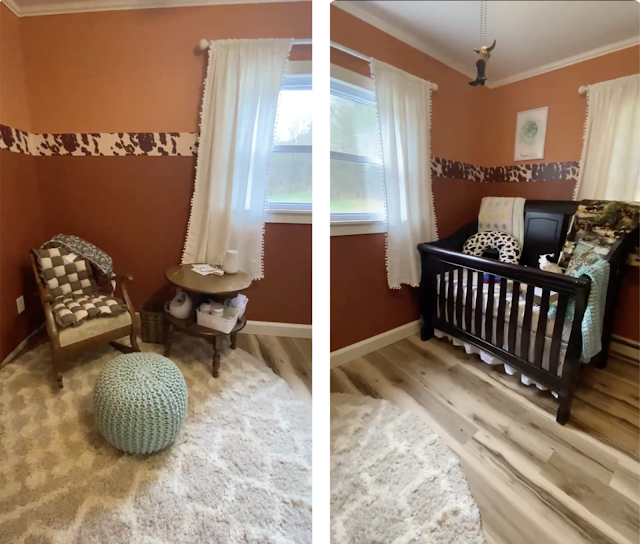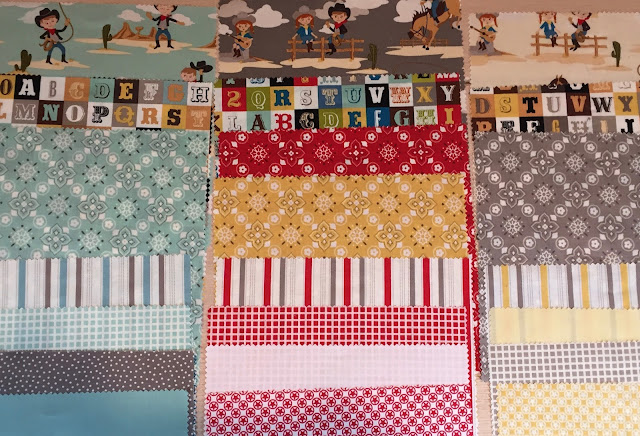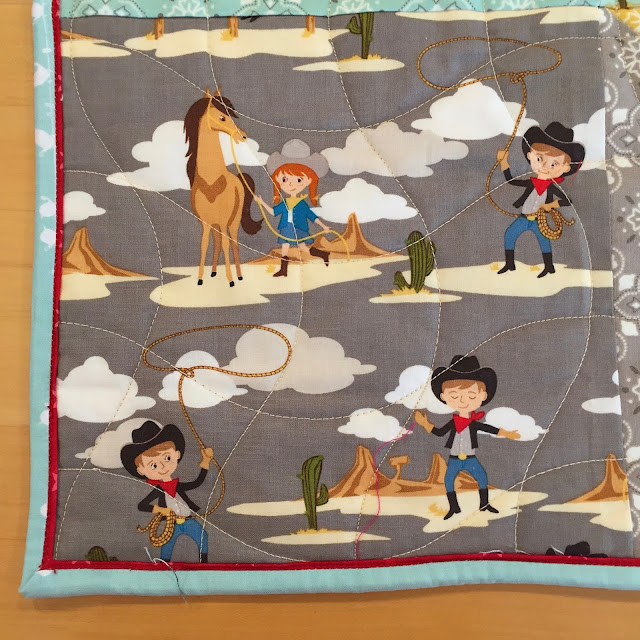My daughter-in-law's brother and his wife were having a baby and chose to not know the gender until the child was born. That is an unfortunate situation for quilt makers. But then I realized, I had not known the gender of my three children now 41, 38, and 35, when they were born, either. I could deal with a post-birth gender reveal several ways. I could make a gender neutral quilt or I could intentionally wait until the baby was born. Or I could procrastinate until the whole decision was moot. I procrastinated. But while I was dallying, I did have in mind some fabric I'd been saving that featured a cowboy and cowgirl in three gender neutral colorways. Several years ago, I'd bought a layer cake of twenty-two 10" squares and also a half yard each of the three feature fabrics. The line was called Sasparilla by Riley Bake Designs, dated from 2013.
Sunday, February 27, 2022
Baby Quilt for a Country Girl
Saturday, February 19, 2022
Third Saturday of February 2022
Beginning April 2020, my quilt guild members began a tradition of hanging quilts in the front of their homes on the third Saturday of the month as a source of enjoyment for the community and as a thank you for the essential workers during the pandemic. My initial post about this practice is dated 4/22/2020. The theme this February was"Valentines" which I interpreted as hearts. For "Hang Your Quilt Day" this month, I chose to hang my quilts Anthurium (completed just yesterday), Doll Quilt, and an untitled cheater cloth wallhanging with baskets and hearts.
I just completed this Hawaiian type wallhanging yesterday. It measure 30" square. My blog post about it is dated 2/18/2022.
Doll Quilt
This is an old favorite displayed before. Made in 2012, it measures 55" x 63". A blog post about it is dated 4/10/2012.
Baskets
I displayed this quilt for an April 2021 "Hang Your Quilt Day" for an Easter Theme but I am pressing it into service this February for a Valentine's theme because of the hearts. Too old, circa 1980's, to have a post of its own, more details of it can be found in my post for the Third Saturday of April 2021. It measures 32" square.
Friday, February 18, 2022
Hawaiian Anthurium
Last summer in July of 2021 my quilt guild held an outdoor sale and I picked up this old 1997 pattern for 50¢. I do like the look of Hawaiian quilts but have no desire to needle turn appliqué one, so this technique, advertised on the pattern front as "Hawaiian style rotary cutting" caught my eye. It included four wallhangings, the two shown in the cover photo, Anthurium and Breadfruit, and two others as I was to learn later, Pineapple and Laua'e (fern). It cried out to be made in batiks. I am not a fan of batiks based on a bad experience my fingers endured on particular quilt when hand sewing on a batik binding, details in my post dated 7/17/13. But I bought the pattern anyway, figuring I would give it a try. Each completed wall hanging will measure 30" square, not too much perimeter to hand stitch if I did decide on a matching batik binding.
Recently, I had been cleaning/organizing/decluttering my sewing room and unearthed the pattern that had been buried for months. It must have been on my mind because that night, when sleep escaped me as it occasionally does, I crept into my sewing room at about 3:00 am and cut out 93 red 2½" squares, 92 white 2½" squares and enough 2⅞" and 3¼" squares to make the required HSTs and QSTs. I sewed up the HSTs and QSTs the next day.Instructions in the pattern were minimal and assumed the quilter would know how to make HSTs and QSTs. Basically the number of squares of each type was called out and a diagram was provided as to how to assemble them. I developed my own process. I sewed all those squares together, like pixels, in rows. On the left, I numbered rows 1 thru 13. I used some arrow stickies to keep track of which unlabeled column I was working on from left to right.


Here are the thirteen rows completed and still strung together to preserve the order. I'd inserted the pins in alternate directions along the left edge to remind myself of pressing direction. I cut each row apart from the rest to iron the seams in a pre-determined direction before joining each row to the next ironed in the opposite direction. I bordered the assembly of thirteen pressed and joined rows with Kona cotton white strips, same as the inner squares. Now I need to pick my backing fabric.
- That colored part is not the flower, but rather a special leaf called a spathe
- A spathe is a cross between a petal and a leaf
- Spathes can come in many colors, pink to red to violet, white, green, and even black
- The flower is that central spike called a spadix
- A spadix is dotted with both the stigma (female) and the stamen (male) tiny parts of the flower










































